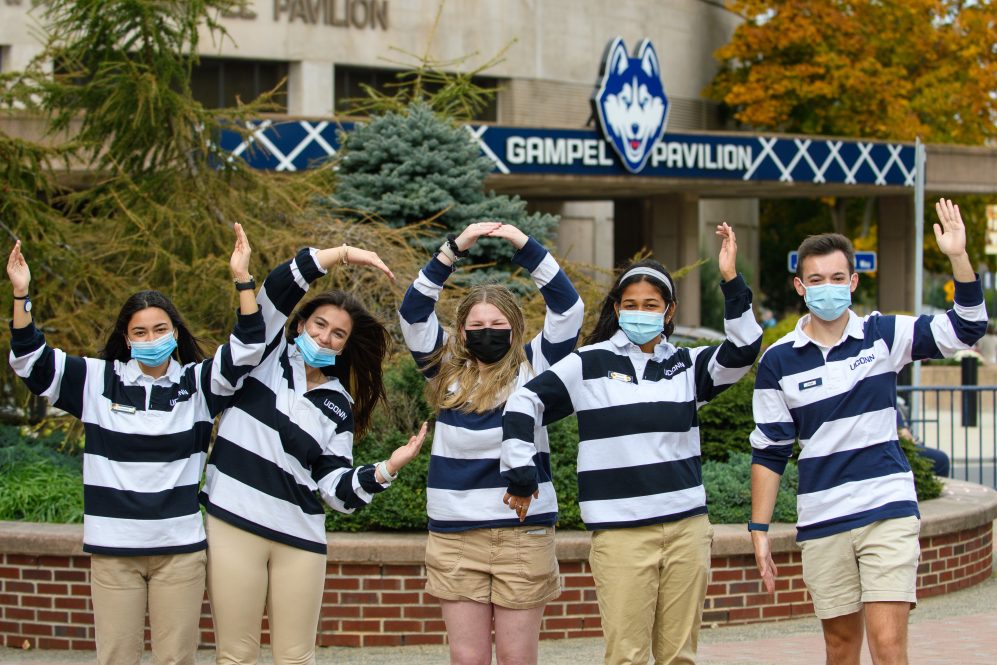UConn remains a top choice for graduating high school students, whose interest in joining the Class of 2026 has propelled the University to a new record high of more than 40,000 applications.
The applications come from Connecticut, other states, and several other nations, and represent the first time UConn has crossed the threshold of 40,000-plus applicants seeking admission as first-year students.
UConn will start extending admissions offers on March 1 to applicants who met the Jan. 15 deadline for spots at Storrs, where it anticipates enrolling a first-year class of about 3,900 students from a diverse range of backgrounds and interests.
UConn’s applications numbers have consistently grown over recent years despite pandemic-related uncertainty, changes in the national economy, and the nationwide and regional decline in the number of high school graduates.
Although those demographic trends have posed challenges for higher education on a broader scale, UConn’s reputation for quality has helped it capture a larger portion of that shrinking applicant pool without compromising on its academic rigor.
“UConn’s talented faculty and its unwavering focus on student success continues to serve as a magnet to draw applicants from throughout Connecticut and beyond,” UConn Interim President Radenka Maric says.
“Our students bring energy and ambition to our campuses, and we know that the next class of incoming Huskies will continue that tradition,” she adds. “We congratulate all of our incoming students, and look forward to providing them the top-tier education that will guide them toward becoming our nation’s next generation of innovators and entrepreneurs.”
Anticipating Roughly 5,500 First-Year Students Across All Campuses
In addition to the approximately 3,900 new students expected to enroll at Storrs, about 1,600 other new first-year students are anticipated at the regional campuses in Hartford, Stamford, Waterbury, and Avery Point. The application period for those campuses runs through May 1, and students wishing to transfer from another institution to UConn have until April 1 to apply.
Vern Granger, UConn’s director of undergraduate admissions, says the University saw an increase in applications from underrepresented racial and ethnic populations and students who would be the first generation in their families to attend college.
“We are proud that UConn continues to attract interest from very diverse and highly accomplished students from Connecticut, and throughout the nation and world,” Granger says. “This speaks to the strength of the University’s brand and perception about the immense quality of the UConn experience.”
Applications from Connecticut students are traditionally high, and were even stronger this year, with 10% growth in that category compared to last year. They came from students in almost all of Connecticut’s 169 towns and cities, and were strong both among those seeking Storrs spots and those applying to regional campuses.
Of particular note, UConn saw an increase of 6.5% over last year in applications from students in Connecticut’s 33 Alliance Districts, which comprise the largest populations of people with significant financial need.
UConn’s talented faculty and its unwavering focus on student success continues to serve as a magnet to draw applicants from throughout Connecticut and beyond. — Interim President Radenka Maric
UConn last year launched its Alliance Pathway program to better connect with talented students in those districts, ensuring they receive information from their guidance counselors about UConn programs, financial aid, resources for first-generation college students, and other details.
The increase in applications from seniors in the Alliance Pathway school districts is particularly gratifying, because it indicates that UConn is succeeding in its goal to draw broadly from the economic, ethnic, racial, and geographic backgrounds of the state’s citizenry – all of which helps build a strong and diverse workforce now and well into the future.
Interest from out-of-state student applicants was also strong as reflected in an 11% increase in applications from that group over the past year. International student applications, which had been negatively impacted by the pandemic and associated travel restrictions, were starting to bounce back with a 19% increase.
Multiple Factors Go Into Admissions Decisions
“In these uncertain times of the pandemic, students and their families are looking for dependable, affordable and smart choices for a college education,” says Nathan Fuerst, UConn’s vice president for enrollment planning and management.
“With exceptional academic programs, abundant and diverse opportunities for an enriched undergraduate experience, and one of the best track records for student success in the country, UConn fits the bill,” he adds.
Health-related majors such as nursing and allied health continue to draw interest among applicants, as do the traditionally popular fields of psychology, business, biological sciences, engineering, and several liberal arts programs.
UConn admissions officers use a wide variety of factors beyond SAT and ACT scores to assess applicants on a holistic basis, including the student’s academic performance, strength of coursework, involvement, and leadership qualities.
UConn is also entering the second year of a three-year pilot program in which undergraduate applicants can decide whether or not they wish to submit their SAT and/or ACT scores to be considered as part of the University’s holistic review.
As was the case last year, the test-optional policy also is believed to have encouraged applications from potential students who might otherwise not have considered UConn to be within reach. In fact, about 65% of last fall’s first-year students applied using the test-optional approach.
UConn has studied the issue internally over the past several years, finding that while students who score very highly on the SAT and ACT tend to be successful at very high levels, the scores are not correlated to success at other ranges.
Students may submit SAT and/or ACT results if they choose, but no admissions decisions were impacted, and no students were disadvantaged if a standardized test score was not provided. Applicants also continue to be automatically considered for merit scholarships and Honors Program eligibility regardless of whether test scores were submitted.
In addition to the approximately 3,900 first-year students expected to enroll at Storrs for fall 2022, UConn forecasts about 1,625 at the regional campuses: Stamford (650), Hartford (550), Waterbury (225), and Avery Point (200).
UConn also plans to enroll 850 transfer students from other institutions, of which about 650 will be based at Storrs. Another 145 students will join the student body as first-year students at UConn Storrs in the spring 2023 semester.
UConn’s undergraduate student body has historically been about 77 percent from Connecticut and about 23 percent from elsewhere, a balance that will continue in the coming academic year and into the foreseeable future.



